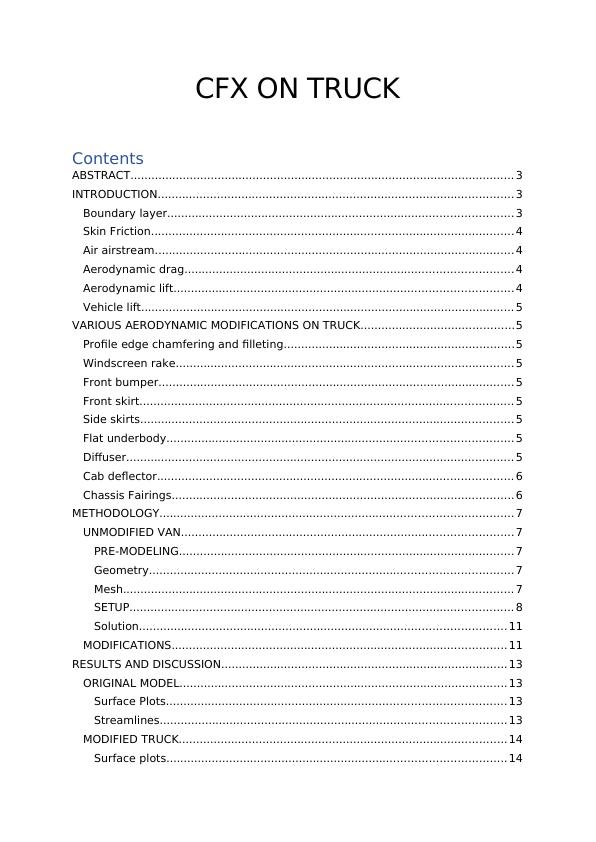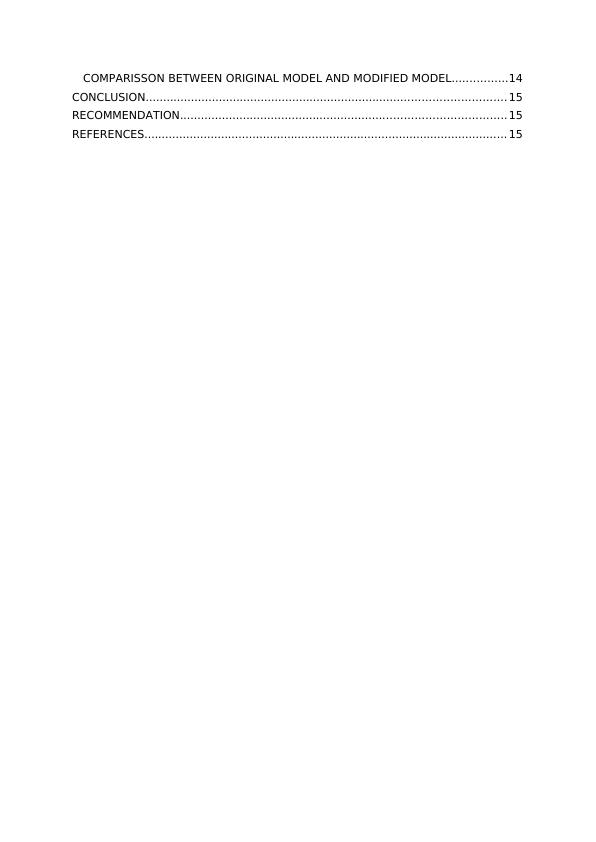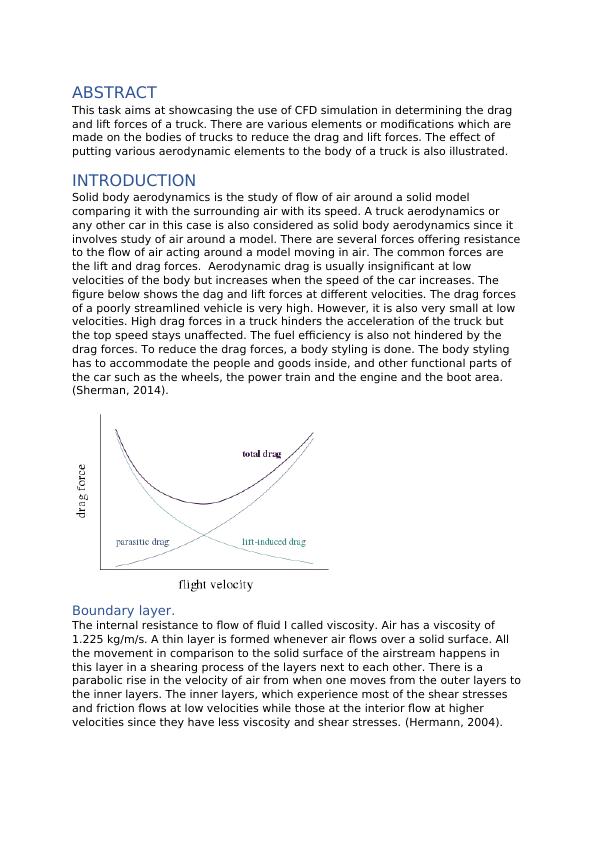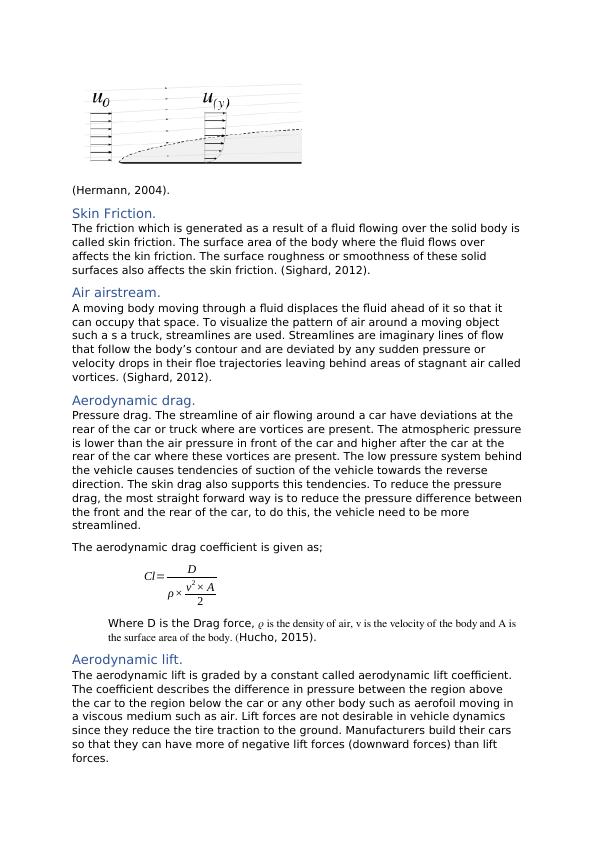CFX on Truck | Assignment Report
Added on 2022-09-01
17 Pages3395 Words15 Views
CFX ON TRUCK
Contents
ABSTRACT.............................................................................................................. 3
INTRODUCTION...................................................................................................... 3
Boundary layer................................................................................................... 3
Skin Friction........................................................................................................ 4
Air airstream....................................................................................................... 4
Aerodynamic drag.............................................................................................. 4
Aerodynamic lift................................................................................................. 4
Vehicle lift........................................................................................................... 5
VARIOUS AERODYNAMIC MODIFICATIONS ON TRUCK............................................5
Profile edge chamfering and filleting..................................................................5
Windscreen rake................................................................................................. 5
Front bumper...................................................................................................... 5
Front skirt........................................................................................................... 5
Side skirts........................................................................................................... 5
Flat underbody................................................................................................... 5
Diffuser............................................................................................................... 5
Cab deflector...................................................................................................... 6
Chassis Fairings.................................................................................................. 6
METHODOLOGY..................................................................................................... 7
UNMODIFIED VAN............................................................................................... 7
PRE-MODELING................................................................................................ 7
Geometry........................................................................................................ 7
Mesh................................................................................................................ 7
SETUP.............................................................................................................. 8
Solution......................................................................................................... 11
MODIFICATIONS................................................................................................ 11
RESULTS AND DISCUSSION.................................................................................. 13
ORIGINAL MODEL.............................................................................................. 13
Surface Plots................................................................................................. 13
Streamlines................................................................................................... 13
MODIFIED TRUCK.............................................................................................. 14
Surface plots................................................................................................. 14
Contents
ABSTRACT.............................................................................................................. 3
INTRODUCTION...................................................................................................... 3
Boundary layer................................................................................................... 3
Skin Friction........................................................................................................ 4
Air airstream....................................................................................................... 4
Aerodynamic drag.............................................................................................. 4
Aerodynamic lift................................................................................................. 4
Vehicle lift........................................................................................................... 5
VARIOUS AERODYNAMIC MODIFICATIONS ON TRUCK............................................5
Profile edge chamfering and filleting..................................................................5
Windscreen rake................................................................................................. 5
Front bumper...................................................................................................... 5
Front skirt........................................................................................................... 5
Side skirts........................................................................................................... 5
Flat underbody................................................................................................... 5
Diffuser............................................................................................................... 5
Cab deflector...................................................................................................... 6
Chassis Fairings.................................................................................................. 6
METHODOLOGY..................................................................................................... 7
UNMODIFIED VAN............................................................................................... 7
PRE-MODELING................................................................................................ 7
Geometry........................................................................................................ 7
Mesh................................................................................................................ 7
SETUP.............................................................................................................. 8
Solution......................................................................................................... 11
MODIFICATIONS................................................................................................ 11
RESULTS AND DISCUSSION.................................................................................. 13
ORIGINAL MODEL.............................................................................................. 13
Surface Plots................................................................................................. 13
Streamlines................................................................................................... 13
MODIFIED TRUCK.............................................................................................. 14
Surface plots................................................................................................. 14

COMPARISSON BETWEEN ORIGINAL MODEL AND MODIFIED MODEL................14
CONCLUSION....................................................................................................... 15
RECOMMENDATION............................................................................................. 15
REFERENCES........................................................................................................ 15
CONCLUSION....................................................................................................... 15
RECOMMENDATION............................................................................................. 15
REFERENCES........................................................................................................ 15

ABSTRACT
This task aims at showcasing the use of CFD simulation in determining the drag
and lift forces of a truck. There are various elements or modifications which are
made on the bodies of trucks to reduce the drag and lift forces. The effect of
putting various aerodynamic elements to the body of a truck is also illustrated.
INTRODUCTION
Solid body aerodynamics is the study of flow of air around a solid model
comparing it with the surrounding air with its speed. A truck aerodynamics or
any other car in this case is also considered as solid body aerodynamics since it
involves study of air around a model. There are several forces offering resistance
to the flow of air acting around a model moving in air. The common forces are
the lift and drag forces. Aerodynamic drag is usually insignificant at low
velocities of the body but increases when the speed of the car increases. The
figure below shows the dag and lift forces at different velocities. The drag forces
of a poorly streamlined vehicle is very high. However, it is also very small at low
velocities. High drag forces in a truck hinders the acceleration of the truck but
the top speed stays unaffected. The fuel efficiency is also not hindered by the
drag forces. To reduce the drag forces, a body styling is done. The body styling
has to accommodate the people and goods inside, and other functional parts of
the car such as the wheels, the power train and the engine and the boot area.
(Sherman, 2014).
Boundary layer.
The internal resistance to flow of fluid I called viscosity. Air has a viscosity of
1.225 kg/m/s. A thin layer is formed whenever air flows over a solid surface. All
the movement in comparison to the solid surface of the airstream happens in
this layer in a shearing process of the layers next to each other. There is a
parabolic rise in the velocity of air from when one moves from the outer layers to
the inner layers. The inner layers, which experience most of the shear stresses
and friction flows at low velocities while those at the interior flow at higher
velocities since they have less viscosity and shear stresses. (Hermann, 2004).
This task aims at showcasing the use of CFD simulation in determining the drag
and lift forces of a truck. There are various elements or modifications which are
made on the bodies of trucks to reduce the drag and lift forces. The effect of
putting various aerodynamic elements to the body of a truck is also illustrated.
INTRODUCTION
Solid body aerodynamics is the study of flow of air around a solid model
comparing it with the surrounding air with its speed. A truck aerodynamics or
any other car in this case is also considered as solid body aerodynamics since it
involves study of air around a model. There are several forces offering resistance
to the flow of air acting around a model moving in air. The common forces are
the lift and drag forces. Aerodynamic drag is usually insignificant at low
velocities of the body but increases when the speed of the car increases. The
figure below shows the dag and lift forces at different velocities. The drag forces
of a poorly streamlined vehicle is very high. However, it is also very small at low
velocities. High drag forces in a truck hinders the acceleration of the truck but
the top speed stays unaffected. The fuel efficiency is also not hindered by the
drag forces. To reduce the drag forces, a body styling is done. The body styling
has to accommodate the people and goods inside, and other functional parts of
the car such as the wheels, the power train and the engine and the boot area.
(Sherman, 2014).
Boundary layer.
The internal resistance to flow of fluid I called viscosity. Air has a viscosity of
1.225 kg/m/s. A thin layer is formed whenever air flows over a solid surface. All
the movement in comparison to the solid surface of the airstream happens in
this layer in a shearing process of the layers next to each other. There is a
parabolic rise in the velocity of air from when one moves from the outer layers to
the inner layers. The inner layers, which experience most of the shear stresses
and friction flows at low velocities while those at the interior flow at higher
velocities since they have less viscosity and shear stresses. (Hermann, 2004).

(Hermann, 2004).
Skin Friction.
The friction which is generated as a result of a fluid flowing over the solid body is
called skin friction. The surface area of the body where the fluid flows over
affects the kin friction. The surface roughness or smoothness of these solid
surfaces also affects the skin friction. (Sighard, 2012).
Air airstream.
A moving body moving through a fluid displaces the fluid ahead of it so that it
can occupy that space. To visualize the pattern of air around a moving object
such a s a truck, streamlines are used. Streamlines are imaginary lines of flow
that follow the body’s contour and are deviated by any sudden pressure or
velocity drops in their floe trajectories leaving behind areas of stagnant air called
vortices. (Sighard, 2012).
Aerodynamic drag.
Pressure drag. The streamline of air flowing around a car have deviations at the
rear of the car or truck where are vortices are present. The atmospheric pressure
is lower than the air pressure in front of the car and higher after the car at the
rear of the car where these vortices are present. The low pressure system behind
the vehicle causes tendencies of suction of the vehicle towards the reverse
direction. The skin drag also supports this tendencies. To reduce the pressure
drag, the most straight forward way is to reduce the pressure difference between
the front and the rear of the car, to do this, the vehicle need to be more
streamlined.
The aerodynamic drag coefficient is given as;
Cl= D
ρ× v2 × A
2
Where D is the Drag force, 𝜌 is the density of air, v is the velocity of the body and A is
the surface area of the body. (Hucho, 2015).
Aerodynamic lift.
The aerodynamic lift is graded by a constant called aerodynamic lift coefficient.
The coefficient describes the difference in pressure between the region above
the car to the region below the car or any other body such as aerofoil moving in
a viscous medium such as air. Lift forces are not desirable in vehicle dynamics
since they reduce the tire traction to the ground. Manufacturers build their cars
so that they can have more of negative lift forces (downward forces) than lift
forces.
Skin Friction.
The friction which is generated as a result of a fluid flowing over the solid body is
called skin friction. The surface area of the body where the fluid flows over
affects the kin friction. The surface roughness or smoothness of these solid
surfaces also affects the skin friction. (Sighard, 2012).
Air airstream.
A moving body moving through a fluid displaces the fluid ahead of it so that it
can occupy that space. To visualize the pattern of air around a moving object
such a s a truck, streamlines are used. Streamlines are imaginary lines of flow
that follow the body’s contour and are deviated by any sudden pressure or
velocity drops in their floe trajectories leaving behind areas of stagnant air called
vortices. (Sighard, 2012).
Aerodynamic drag.
Pressure drag. The streamline of air flowing around a car have deviations at the
rear of the car or truck where are vortices are present. The atmospheric pressure
is lower than the air pressure in front of the car and higher after the car at the
rear of the car where these vortices are present. The low pressure system behind
the vehicle causes tendencies of suction of the vehicle towards the reverse
direction. The skin drag also supports this tendencies. To reduce the pressure
drag, the most straight forward way is to reduce the pressure difference between
the front and the rear of the car, to do this, the vehicle need to be more
streamlined.
The aerodynamic drag coefficient is given as;
Cl= D
ρ× v2 × A
2
Where D is the Drag force, 𝜌 is the density of air, v is the velocity of the body and A is
the surface area of the body. (Hucho, 2015).
Aerodynamic lift.
The aerodynamic lift is graded by a constant called aerodynamic lift coefficient.
The coefficient describes the difference in pressure between the region above
the car to the region below the car or any other body such as aerofoil moving in
a viscous medium such as air. Lift forces are not desirable in vehicle dynamics
since they reduce the tire traction to the ground. Manufacturers build their cars
so that they can have more of negative lift forces (downward forces) than lift
forces.

End of preview
Want to access all the pages? Upload your documents or become a member.
Related Documents
The Boundary layerlg...
|15
|3443
|26
General and History of Automotive Aerodynamicslg...
|26
|6371
|218
THERMODYNAMICS AND FLUID MECHANIC 20lg...
|22
|2263
|18
Aerodynamic Research: Overview, History, and Applicationslg...
|12
|2991
|376
Course Instructor Institution Locationlg...
|13
|2113
|50
Aircraft: Role of Aerofoil in Generating Liftlg...
|6
|1580
|38
